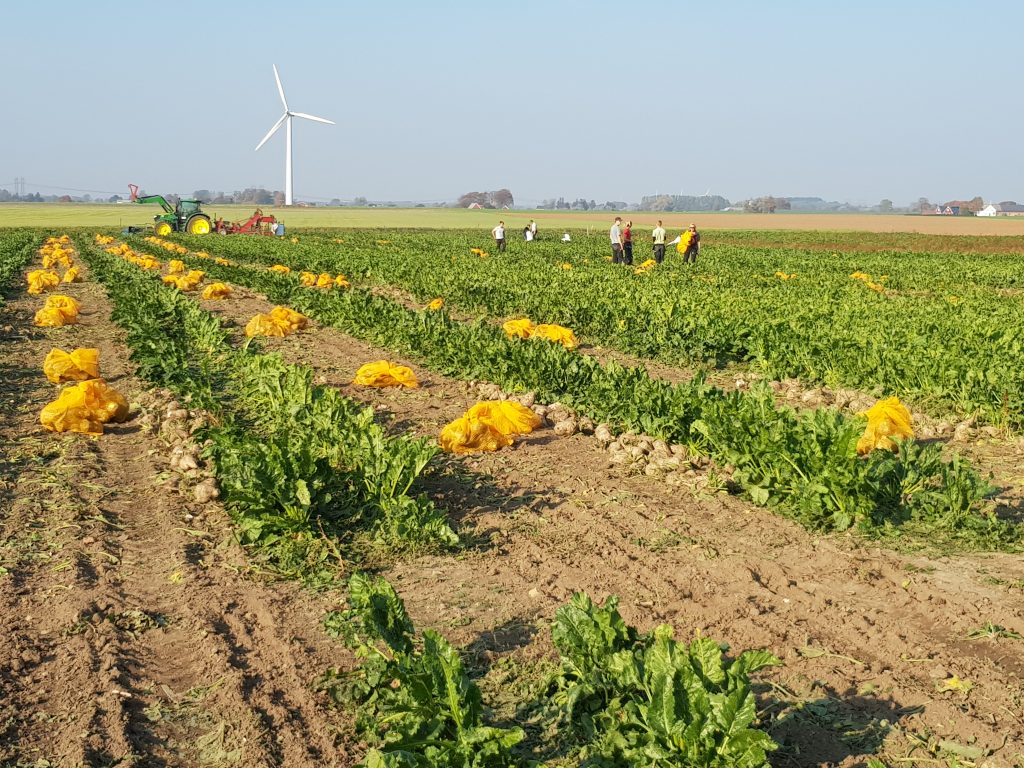This project ran as part of the COBRI* collaboration during 2018 and 2019. The final report from this project was published as a scientific article in Sugar Industry with the title Root texture and storage losses of sugar beet varieties as affected by N application and irrigation. It sits behind a paywall. There is also a ResearchGate posting of this article.
Project members: Christa Hoffmann** (IfZ), Gunnar Kleuker (IfZ), Martijn Leijdekkers (IRS), Francoise Vancutsem (IRBAB), Joakim Ekelöf (NBR), William English (NBR).
ABSTRACT FROM FINAL REPORT
“There is some evidence that sugar beet root tissue strength affects damage susceptibility and storage losses. This study aimed at analyzing the effect of N application and of irrigation on tissue strength of sugar beet varieties, on root composition, and on root tip breakage and storage losses. For this purpose, field trials in six replicates with three sugar beet varieties were carried out with three N doses in The Netherlands and Belgium in 2018 and 2019, alternatively with three irrigation treatments in Sweden in 2018 and 2019. Results show a low impact of N application and irrigation on puncture resistance, tissue firmness and compressive strength of the roots, while varieties differed always stronger and significantly. Cell wall composition (pectin, hemicellulose, cellulose, lignin) did not differ markedly in roots from different environments (sites, years) and varieties, giving no explanation for differences in tissue strength. However, the percentage of cell wall material (AIR, marc) and of dry matter were higher in roots with higher tissue strength. Root tip breakage and sugar losses during storage tended to be lower when root compressive strength of varieties was higher. Hence, root tissue strength could serve as an indirect selection criterion for reduced damage susceptibility and improved storability of sugar beet varieties.”
RATIONALE FROM AN APPLIED SCIENCE VIEWPOINT
If the correlations between variety, damage, and storage losses could also be shown to exist for agronomic practice, damage, and storage, then sugar beet growers could consider this when making decisions about the storage of their sugar beet. Available N and available H2O were chosen as the agronomic practices to concentrate on as they are known to have large impacts on other traits of sugar beet, such as yield.
DESIGN
- 3 Countries. Belgium, the Netherlands, Sweden.
- 2 Years. 2018 and 2019.
- 6 Trial sites. 1 per country and year.
- 2 Factors. Variety and key agronomic practice
- 1 set of 3 Varieties.
- One of each of E-, N-, and Z- type, but not chosen to represent these types.
- 2 sets of 3 levels of a key agronomic practice. Available N (BE and NL), Available H2O (SE)
- N (application in spring):
- 0 kg.ha-1 additional N
- ca. 120 kg.ha-1
- ca. 200 kg.ha-1.
- H2O (more details on application rates below):
- no irrigation
- optimal irrigation
- heavy irrigation during the last month of growth
- N (application in spring):
- 1 set of 3 Varieties.
- 6 replicates per trial site.
- 54 plots per trial (3 varieties x 3 agronomic practice levels x 6 replicates)
- Split plot designs were employed at all trial sites, with the agronomic practice constituting the main plots.
Water applied during the growing season in SE was recorded as:
- 2018:
- 152mm rainfall
- 152mm rainfall + 135mm irrigation (5 passes)
- 152mm rainfall + 60mm irrigation (2 passes)
- 2019:
- 359mm rainfall
- 359mm rainfall + 118mm irrigation (4 passes)
- 359mm rainfall + 35mm irrigation (1 passes)
KEY NOVEL FINDING FROM AN APPLIED SCIENCE VIEWPOINT
The key agronomic practices of nitrogen application and irrigation have relatively little impact on the mechanical properties of sugar beet. The effect of variety was much larger. High in-season water availability (“optimal irrigation” – Sweden) was the only agronomic treatment that had a large effect on storabilty. This effect was a large increase in the percentage loss of the originally available sugar (i.e. a negative effect from a management perspective). The mechanism is not known.

* COBRI is the COordination Beet Research International. It consists of four national sugar beet research institutes, representing five sugar beet growing nations: IRS in the Netherlands, IRBAB in Belgium, IfZ in Germany, and NBR in Sweden and Denmark. These institutes work together through the collaboration on projects that have agro-ecological, management, policy, or other relevance to the sugar beet industries in the partner countries.
** lead researcher and contact
Further publications using results from this project:
G. Kleuker and C. M. Hoffmann (2020) Influence of tissue strength on root damage and storage losses of sugar beet, Zuckerindustrie/ Sugar industry, Vol. 145 Issue 7 Pages 435-443. DOI: 10.36961/si24556